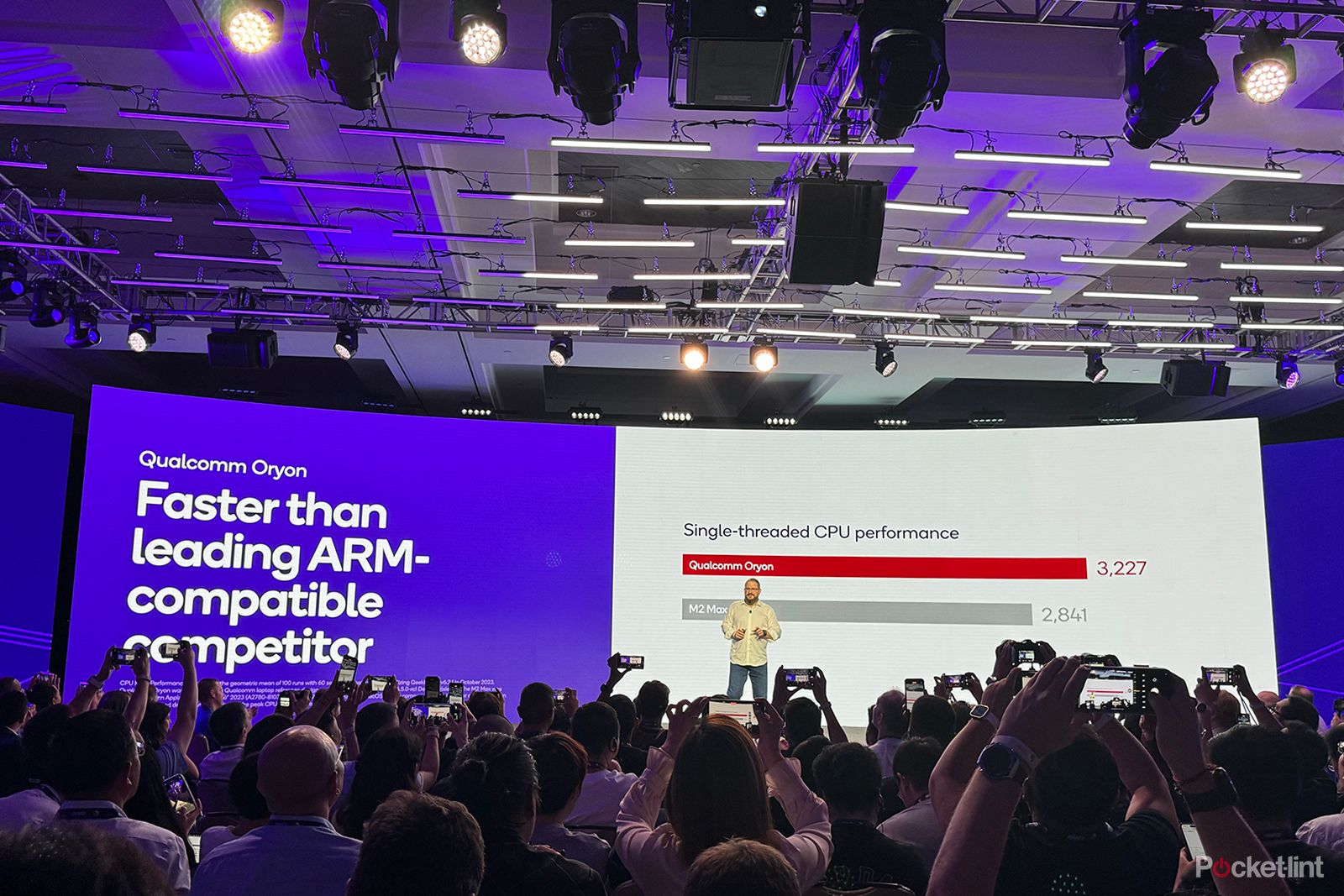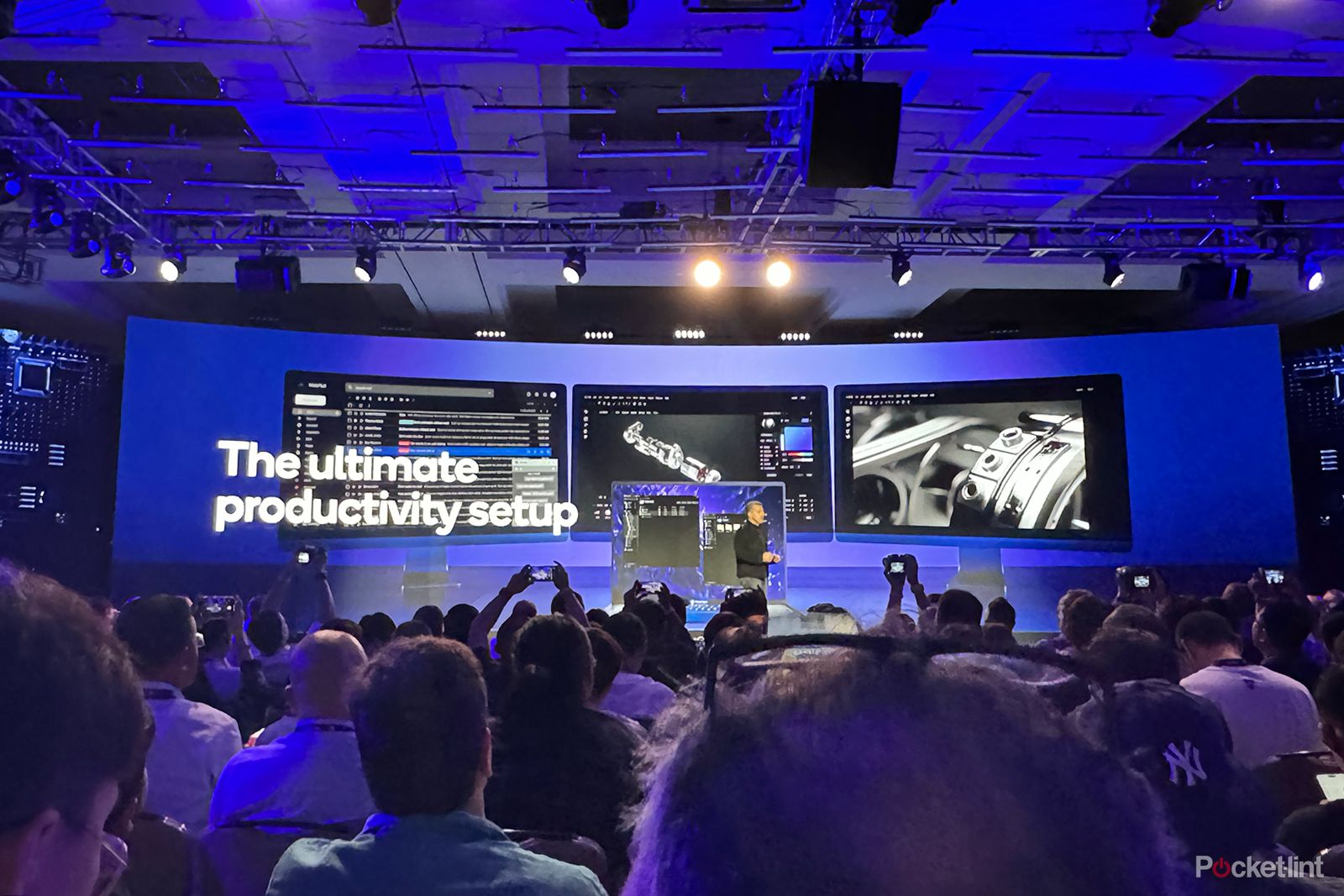Key Takeaways
- The Snapdragon X Elite Platform is Qualcomm’s most powerful processor for Windows PCs, boasting 2x faster CPU performance than competitors with 65 per cent less power consumption and promising multiple days of battery life
- In terms of graphics, the platform features the Qualcomm Adreno GPU, delivering 2x faster performance and supporting up to 4.6 teraflops for stunning visuals and immersive entertainment.
- The Snapdragon X Elite Platform is built for AI, offering 4.5x faster AI NPU processing power than competitors. It supports on-device AI with generative AI models and enhances productivity with support for Windows Studio Effects and AI-accelerated applications.
Qualcomm announced a rebrand of its PC processors in the middle of October a matter of weeks before the Snapdragon Summit kicked off. While it initially kept things vague, only revealing the platforms would fall under the Snapdragon X Series, the Snapdragon Summit detailed plenty more about what we can expect from these platforms and what the future of PCs could look like.
This is everything you need to know about the Snapdragon X Elite Platform, claimed to be the most powerful, intelligent, and efficient processor ever created for Windows in its class. How powerful is it, what features does it offer and can it beat Apple’s M-series chips?
How powerful is the Snapdragon X Elite?
The Qualcomm Snapdragon X Elite Platform features the company’s Oryon CPU that is built on a 4nm 64-bit architecture. There are 12 high-performance cores, each offering up to 3.8Ghz, designed to optimise demanding workloads. The platform also offers a Dual-Core Boost up to 4.3Ghz for faster responsiveness when needed.
Qualcomm has said the Snapdragon X Elite delivers up to 2x faster CPU performance compared to Intel’s i7-13800H (14-core), whilst matching peak performance with 65 per cent less power consumption. There’s promise of up to multiple days of battery life, which if accurate, would be a substantial improvement for PCs.
In terms of graphic performance, there’s the Qualcomm AdrenoTM GPU on board, supporting up to 4.6 teraflops and claimed to deliver 2x faster performance than the x86 for what should be stunning graphics and immersive entertainment.
Elsewhere, the Snapdragon X Elite Platform features Qualcomm’s AI Engine with an integrated Qualcomm Hexagon NPU, claimed to offer 4.5x faster AI NPU processing power than competitors. The AI Engine offers up to 75 TOPs, while the NPU offers up to 45 TOPs.
There’s also LPDDR5x memory with 136GB/s bandwidth and 48MB total cache, useful for efficient multi-tasking, alongside faster AI experiences – the latter of which is a key feature of what Qualcomm is trying to deliver to mobile computing with the Snapdragon X Elite platform.
How does the Snapdragon X Elite Platform compare to Apple’s M series?
Qualcomm made some bold statements about the X Elite Platform during its Snapdragon Summit, some of which centred around Apple’s very impressive M2 series of chipsets. Apple may be about to announce its M3 chips and it seems the timing of that couldn’t be more perfect for the Cupertino company based on the X Elite platform’s claims.
According to Qualcomm, the Snapdragon X Elite Platform offers up to 2x faster peak performance than Apple’s M2 chip. President & CEO of Qualcomm, Cristiano Amon, also highlighted some benchmarking results on stage at the Snapdragon Summit against the M2 Max – Apple’s current most powerful chip. For single-threaded CPU performance, the Qualcomm Oryon CPU scored 3227 compared to the M2 Max’s 2841 and apparently it does this with 30 per cent less power.
Benchmarking scores don’t tell the full story of course as there are a number of other factors that will determine how well a platform performs – including the hardware it is running – so how the Snapdragon X Elite will stack up against the M2 chips in real world use will have to wait until devices arrive in 2024.
Apple has an advantage in that it controls the hardware, the silicon platform running that hardware and the software too, so it can guarantee performance to a certain degree as it is managing many of the variables in house. Qualcomm meanwhile, offers the platform, but it’s then down to OEMs like HP, Lenovo and Microsoft to deliver the hardware and software to get the most out of the platform. Still, the numbers and scores presented by Qualcomm for the Snapdragon X Elite are very promising and are definitely bringing the fight to Apple, finally. At least until the M3 chips are announced anyway.
What features does the Snapdragon X Elite Platform offer?
AI – and specifically on-device and generative AI – was a key topic for Qualcomm throughout its Snapdragon Summit 2023, with a number of features revealed to enhance the mobile computing experience using on-device AI for more privacy and quicker response times. Qualcomm highlighted that the smartphone set the pace for innovation and that it was time for the PC to catch up. Here’s are some of the key features offered by the Snapdragon X Elite platform.
AI
Qualcomm said the Snapdragon X Elite was built for AI and that’s evident in some of the use cases the company showed off during its Snapdragon Summit, from asking an AI assistant to design a pair of trainers to creating an invoice or planning a trip. The platform is said to be capable of running generative AI LLM models over 13B parameters on-device with super fast speeds and generates 30 tokens per second for 7B LLMs.
There’s an updated Micro NPU inside the Qualcomm Sensing Hub for enhanced security, login experience, and privacy, allowing sensitive data to stay on your laptop. The AI Engine we mentioned previously supports Windows Studio Effects and other AI-accelerated applications and experiences, offering plenty of potential for enhanced productivity and AI experiences that are actually helpful to getting more done – or better yet, doing some of the more mundane tasks for you entirely.
Displays
The Snapdragon X Elite platform features the Qualcomm Adreno Display Processing Unit (DPU) and it supports a maximum on-device display resolution of up to 4K with a 120Hz refresh rate and HDR10. That should be plenty for the majority of laptops, delivering crisp detail and decent scrolling speeds if those specs were adopted.
The platform also supports up to three external displays, all with 4K displays with 60Hz refresh rates and HDR10, or two 5K external displays with 60Hz refresh rates, so there’s flexibility to create a great workspace.
Camera and video
The Snapdragon X Elite features Qualcomm’s Snapdragon Sight with Advanced MIPI camera support, offering a number of features like auto-framing, background blur, and facial authentication at lower power consumption. It’s also claimed to be the first PC processor with an integrated Always-Sensing ISP that is 2x more powerful in AI performance and offers 50 per cent more memory.
The Snapdragon X Elite supports dual cameras up to 36-megapixels or a single camera up to 64-megapixels, which is more than you would find on most smartphones in terms of front facing cameras so there’s potential for much clearer and more detailed video calls from built-in web cameras here. The platform also supports 4K HDR video capture and AV1 encode and decode.
Connectivity
The Snapdragon X Elite has Snapdragon Connect suite of features on board, along with the Qualcomm FastConnect 7800 System, offering support for Wi-Fi 7, Wi-Fi 6E and Wi-Fi 6 and 802.11be, 802.11ax, 802.11ac, 802.11n, 802.11g, 802.11b, 802.11a standards. There’s also support for 6GHz, 5GHz, 2.4GHz spectral bands.
As you would expect, 5G is also supported, as well as mmWave, with peak download speeds of 10Gbps and upload speeds of 3.5Gbps from the X65 5G Modem-RF system. There’s also a HBS Multi-Link for minimised latency and jitter-free entertainment. Overall, connectivity should be on point for devices running the Snapdragon X Elite platform – it’s Qualcomm’s bread and butter after all.
What devices will run on the Snapdragon X Elite Platform?
A number of partnerships have been announced for the Snapdragon X Elite Platform, with Microsoft, Lenovo and HP all on board, alongside Honor, Samsung, Asus and Acer, so there’s quite the potential here.
Unlike the Snapdragon 8 Gen 3 mobile platform, no specific products have been revealed yet for the Snapdragon X Elite from these OEMs, though it is expected we will see the first devices appear in mid-2024. Stay tuned and we will update this feature as and when companies announce specific devices.
It’s worth mentioning that Qualcomm has said the X Elite Platform will be compatible with multiple form factors, from standard laptops to 2-in-1s so it’s likely we will see numerous options running this platform by the end of 2024.
Trending Products

Cooler Master MasterBox Q300L Micro-ATX Tower with Magnetic Design Dust Filter, Transparent Acrylic Side Panel, Adjustable I/O & Fully Ventilated Airflow, Black (MCB-Q300L-KANN-S00)

ASUS TUF Gaming GT301 ZAKU II Edition ATX mid-Tower Compact case with Tempered Glass Side Panel, Honeycomb Front Panel, 120mm Aura Addressable RGB Fan, Headphone Hanger,360mm Radiator, Gundam Edition

ASUS TUF Gaming GT501 Mid-Tower Computer Case for up to EATX Motherboards with USB 3.0 Front Panel Cases GT501/GRY/WITH Handle

be quiet! Pure Base 500DX ATX Mid Tower PC case | ARGB | 3 Pre-Installed Pure Wings 2 Fans | Tempered Glass Window | Black | BGW37

ASUS ROG Strix Helios GX601 White Edition RGB Mid-Tower Computer Case for ATX/EATX Motherboards with tempered glass, aluminum frame, GPU braces, 420mm radiator support and Aura Sync
















